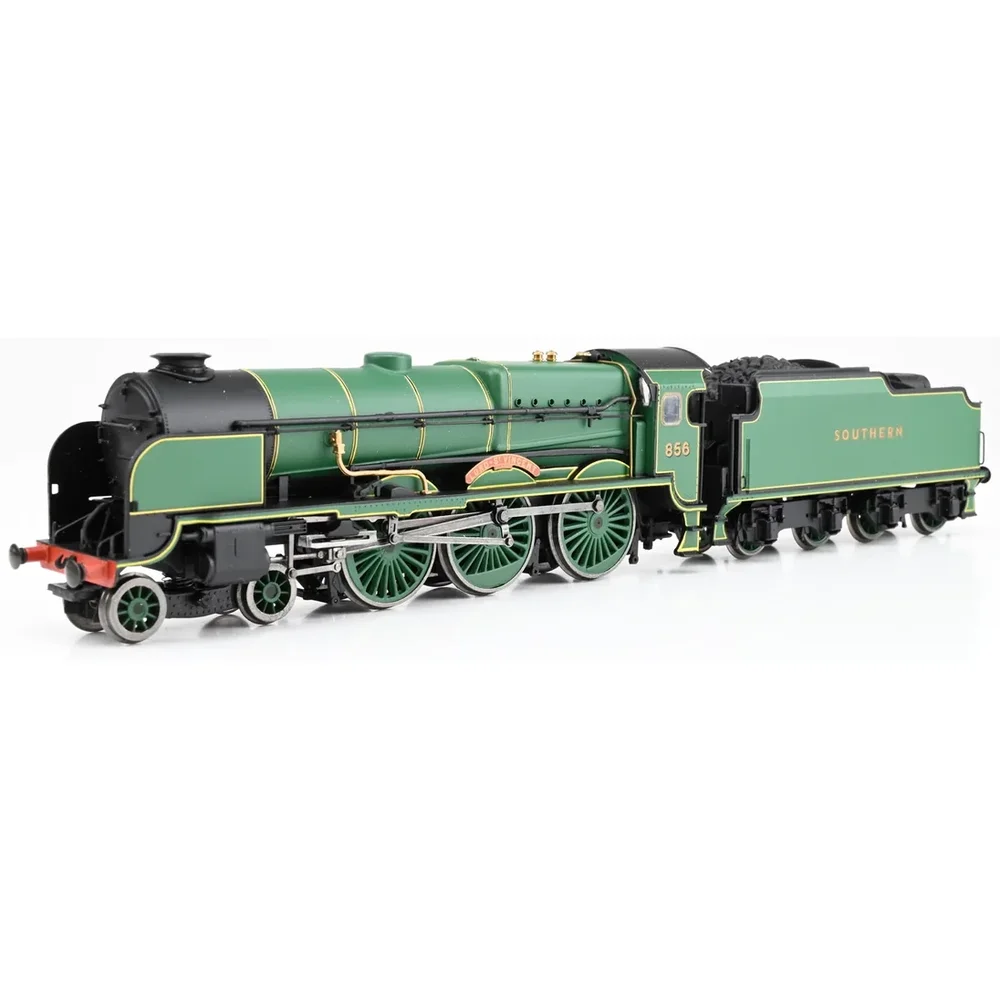Bachmann 31-407
Southern Railway Lord Nelson 856 "Lord St Vincent" Southern Railway Lined Green
Tooling
Bachmann Branchline introduced its OO gauge model of the Southern Railway Lord Nelson Class in 1992 as part of its Blue Riband range. This represented Maunsell’s 4-cylinder 4-6-0 express passenger locomotive, designed for heavy Continental boat trains and later express services. The tooling remained in production until 2002, with reissues in 2005 and 2008. It was considered highly detailed for its time but has since been surpassed by modern standards.
Tooling Features
- Scale: OO gauge (1:76).
- Construction: Die-cast split chassis with plastic body and tender.
- Detailing: Separately fitted chimney (two styles: Maunsell and Bulleid Lemaitre), moulded lamp irons, handrails, and rivet detail. Tender steps supplied for user fitting.
- Couplings: Originally tension-lock; later releases adopted slimline couplings (not NEM pockets).
Mechanical & Electrical
- Motor & Drive: Large 3-pole can motor mounted in split chassis, driving main axles.
- Pickups: On driving axles only; no tender pickups.
- Minimum Radius: 2nd radius (approx. 438 mm), though rear tender steps may foul curves if fitted.
- Lighting: None.
- Weighting: Die-cast chassis provided good traction and smooth running.
DCC Capability
The model was DCC incompatible as supplied. Conversion requires full motor isolation and rewiring due to split chassis design. Enthusiasts have successfully fitted decoders and even sound, but it is considered a challenging upgrade.
Liveries Produced
The tooling covered Southern Railway and British Railways periods, including:
- SR Malachite Green (e.g., No. 850 “Lord Nelson”, limited edition).
- SR Maunsell Green (post-1931 style).
- BR Brunswick Green with early emblem.
- BR Brunswick Green with late crest.
Variations included different chimneys and lining styles. All models used the high-sided tender design.
Reviews & Commentary
At launch, the model was praised for accuracy and smooth running. Over time, shortcomings became apparent: tender length slightly underscale, lack of fine details such as cylinder drain pipes, and prominent pony truck wheel rims. Despite this, reliability and performance were generally rated highly, with many examples still running well decades later. Later releases improved paint finish and lining quality.
Media & Community Feedback
Collectors value early limited editions, particularly the 850 “Lord Nelson” in presentation boxes. Online forums note the split chassis as robust but requiring care for long-term maintenance. Conversion to DCC remains a popular topic among enthusiasts.
Interesting Notes
- The tooling never received a full retool; only minor updates like couplings and finish were applied.
- Two chimney styles were offered, reflecting prototype modifications.
Class & Prototype
- Class: Southern Railway Lord Nelson
- Traction: Steam
- Built: 1926-1929
- Total Built: 16
No prototype found.
Operator & Livery
- Operator: Southern Railway
- Livery: Lined Green
The Southern Railway (SR), formed in 1923 through the amalgamation of numerous railway companies, became Britain's most passenger-focused railway company. The three principal constituents were the LSWR, LB&SCR, and SE&CR, alongside several smaller railways including the Plymouth, Devonport and South Western Junction Railway and various light railways. Operating 2,186 miles across southern England, the SR pioneered extensive third-rail electrification and developed distinctive locomotive classes under Chief Mechanical Engineers Maunsell and Bulleid. The company's malachite green and olive green liveries, Art Deco architecture, and premium passenger services like the Golden Arrow established new British railway standards. Nationalised in 1948, the SR's innovations in electric traction and passenger comfort influenced modern railway practice. Today, SR locomotives remain highly popular with railway modellers for their elegant designs, varied operational roles, and distinctive Southern Railway heritage that connected London with the Channel ports and southern resorts.
